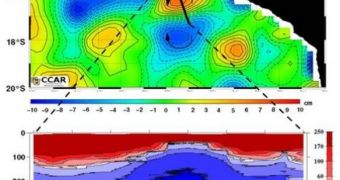A group of researchers from Germany argues that small-scale oceanic circulation patterns called eddies are responsible for controlling the concentration of oxygen in so-called oxygen-minimum zones (OMZ) of the Atlantic Ocean. Water hypoxia, or oxygen deprivation, is slowly becoming a global problem.
Hypoxia is caused by a variety of factors. Closer to the shoreline, it is produced by massive amounts of algae, which consume the chemical and makes life impossible for other marine lifeforms. This happens because rivers carry vast amounts of nitrogen from agricultural fertilizers.
These chemicals promote the growth of algae, and inhibit the growth of everything else. Scientists have been keeping an eye on hypoxic areas and OMZ for many years, in a bid to monitor how these regions evolve over time, and see how oceanic circulation influences oxygen concentrations.
This was also the purpose of the new investigation, conducted by scientists with the Helmholtz Center for Ocean Research Kiel (GEOMAR). The team used the scientific research vessel METEOR to collect and analyze water samples from the tropical Pacific Ocean.
Their work revealed that ocean eddies were responsible for controlling the concentration of water oxygen. This was hypothesized some time ago, but was never before proven with empirical data, Science Daily reports.
Details of the study, which also included scientists from the Instituto del Mar del Peru (IMARPE), appear in the latest issue of the esteemed scientific journal Biogeosciences. The paper reveals that oxygen concentrations off the coasts of Peru have been declining steadily for at least 10 years.
The German-Peruvian team investigated this area between November 2012 and March 2013, and sampled water from three eddies that were identified from satellite data before the study started.
“Our observations show that eddies transport water with strong differences compared to the surrounding waters in temperature, salinity, oxygen and nutrients while moving westwards with a few centimeters per second,” explains GEOMAR scientist Dr. Lothar Stramma.
“As the eddies dissipate after some weeks to months anomalies of these properties are introduced as disturbances into the open ocean and hence are responsible for surprisingly high productivity in the normally nutrient-poor open ocean,” adds the expert, who was the lead author of the new study.
The research effort also included German scientists from the Max Planck Institute Bremen and the Christian-Albrechts University Kiel (CAU). The work is sponsored by the German Research Foundation (DFG).

 14 DAY TRIAL //
14 DAY TRIAL //